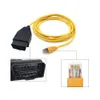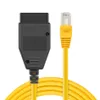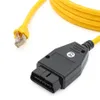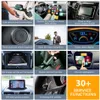Efficient BMW diagnostics and programming are essential for technicians and enthusiasts to properly maintain their vehicles. However, challenges often arise when attempting to diagnose and program the vehicle’s various systems. The ENET cable is a specialized diagnostic tool that can help overcome these challenges. It features high-speed data transfer, wide compatibility with different BMW models and systems, and user-friendly interface. Step-by-step instructions on how to connect the ENET cable to a BMW vehicle, access relevant software and tools, and perform various diagnostic and programming tasks are provided in the article. Compared to other commonly used diagnostic tools, the ENET cable offers precision and accuracy, advanced features and settings, and cost-effectiveness. Overall, the ENET cable is a must-have tool for efficient and effective BMW maintenance and repair.








Introduction: The importance of efficient BMW diagnostics and programming.
Efficient BMW diagnostics and programming are critical to the proper functioning of a BMW vehicle. However, BMW technicians and enthusiasts often encounter common challenges when it comes to diagnosing and programming the various systems within a BMW. This article will discuss these common challenges and highlight the benefits of using specialized diagnostic tools and equipment such as the ENET cable.
Common Challenges:
One of the most common challenges faced by BMW technicians and enthusiasts is the complexity of the BMW’s various electronic systems. BMWs have multiple electronic components that work together to ensure the vehicle’s proper functioning. These components include the engine control unit (ECU), transmission control module (TCM), and the body control module (BCM). Each of these modules communicates with one another through a network known as the Controller Area Network (CAN). Diagnosing faults in this network can be a daunting task for technicians and enthusiasts who lack the necessary tools and expertise.
Another common challenge is the lack of accurate diagnostic information. BMWs are highly sophisticated vehicles, and their electronic systems are constantly evolving. Technicians and enthusiasts require up-to-date, accurate diagnostic information to diagnose and repair faults in the system. Without this information, they may struggle to identify the root cause of the problem, leading to increased diagnostic time and higher repair costs.
Benefits of Specialized Diagnostic Tools and Equipment:
The use of specialized diagnostic tools and equipment, such as the ENET cable, can alleviate some of the challenges associated with diagnosing and programming BMWs. The ENET cable is a diagnostic tool specifically designed for BMWs, and it provides access to the vehicle’s Electronic Control Unit (ECU) through the OBD-II port. This tool allows technicians and enthusiasts to perform diagnostics, coding, and programming on BMWs.
The ENET cable has several advantages over traditional diagnostic tools. Firstly, it provides access to more detailed diagnostic information about the vehicle’s systems. This information allows technicians and enthusiasts to diagnose faults more accurately and efficiently, ultimately reducing diagnostic time and repair costs. Secondly, the ENET cable enables users to program and code the various systems within a BMW. This feature allows technicians and enthusiasts to customize the vehicle’s settings to suit their specific needs, enhancing the driving experience.
What is the ENET cable?
One of the most notable features of the ENET cable is its high-speed data transfer capability. This allows for quick and efficient transmission of data between the vehicle and the computer, saving time and increasing productivity. Additionally, the ENET cable is known for its wide compatibility with different BMW models and systems. Whether it’s an older E-series vehicle or a newer F-series model, the ENET cable can be used across a variety of BMW vehicles, making it a versatile and valuable tool for any BMW enthusiast or technician.
Moreover, the ENET cable is equipped with a user-friendly interface, making it easy to use for individuals of all skill levels. Its plug-and-play design ensures that users can quickly set it up and start using it without the need for complicated installation processes. This user-friendly interface also extends to the software that accompanies the ENET cable, providing a seamless and intuitive experience for users.
How to use the ENET cable for BMW diagnostics and programming.
Step 1: Connect the ENET cable to your BMW
Before you can start using the ENET cable, you need to connect it to your BMW. To do this, locate the OBD-II port on your BMW and plug in the ENET cable. The OBD-II port is usually located under the dashboard on the driver’s side. Once you have plugged in the ENET cable, turn on the ignition and start up your BMW.
Step 2: Access the relevant software and tools
To use the ENET cable for BMW diagnostics and programming, you need to have the right software and tools. There are many different options available, but some of the most popular include Carly for BMW, BimmerCode, and ISTA+. These programs allow you to access and control various systems on your BMW, including the engine, transmission, brakes, and more.
Step 3: Perform various diagnostic and programming tasks
Once you have connected the ENET cable to your BMW and accessed the relevant software and tools, you can start performing various diagnostic and programming tasks. Some of the most common tasks include:
– Reading and clearing fault codes
– Checking and resetting service intervals
– Coding and programming new features
– Changing parameters and settings
– Calibrating sensors and components
Tips and Tricks for Using the ENET Cable for BMW Diagnostics and Programming
While using the ENET cable for BMW diagnostics and programming can be a powerful tool, there are some tips and tricks that can help you get the most out of it:
1. Make sure you have the right software and tools for your BMW model and year. Different software and tools may be required depending on the make and model of your BMW.
2. Always read and follow the instructions carefully. This will help you avoid common errors or issues that can arise when using the ENET cable.
3. Back up your data before making any changes. This will allow you to restore your BMW to its previous state if something goes wrong during the coding or programming process.
4. Be patient and take your time. Performing diagnostic and programming tasks with the ENET cable can take time, so don’t rush through the process.
5. Always test your changes thoroughly before driving your BMW. This will help you ensure that everything is working properly and safely.
Advantages of using the ENET cable over other diagnostic tools.
First and foremost, the precision and accuracy of the ENET cable set it apart from other diagnostic tools. Unlike generic OBD-II scanners that provide limited information about the vehicle’s systems, the ENET cable allows for more comprehensive and detailed diagnostics. This enables users to pinpoint issues with greater accuracy, leading to more effective and efficient repairs.
Additionally, the ENET cable provides access to more advanced features and settings within the vehicle’s systems. While handheld devices and OBD-II scanners may offer basic functionality, they often lack the ability to delve into the more complex inner workings of BMW vehicles. With the ENET cable, users can access and modify advanced settings that are crucial for diagnosing and resolving intricate issues.
Cost-effectiveness is another key advantage of the ENET cable. When compared to the expense of purchasing multiple handheld devices or specialized OBD-II scanners for different functions, the ENET cable offers a more economical solution. By consolidating various diagnostic capabilities into one tool, the ENET cable not only saves money but also streamlines the diagnostic process.
Furthermore, the versatility of the ENET cable cannot be overlooked. While OBD-II scanners and handheld devices are limited to specific functions, the ENET cable is adaptable to a wide range of diagnostic tasks. Whether it’s coding, programming, or simply reading fault codes, the ENET cable proves to be a versatile and comprehensive tool for BMW vehicles.
Conclusion: Why the ENET cable is a must-have for BMW technicians and enthusiasts.
The ENET cable is a diagnostic tool that connects your BMW car to a computer or laptop through its Ethernet port. The cable allows you access to the car’s onboard computer system, enabling you to diagnose faults, read error codes, and even program new features in your car.
One of the key benefits of using an ENET cable is that it offers a more efficient and effective way of diagnosing faults in your BMW car. As compared to traditional diagnostic tools, the ENET cable provides detailed real-time data that can help identify problems accurately and quickly. This means that you can fix the issue before it becomes costly to repair, saving you time, money, and effort.
Another reason why the ENET cable is a must-have for BMW technicians and enthusiasts is its versatility. The cable is compatible with a wide range of BMW models, making it easy for users to use it on multiple cars. Additionally, the ENET cable is easy to operate, even for beginners, thanks to its user-friendly interface and comprehensive instructions.
Furthermore, the ENET cable helps to keep your car’s software up-to-date, ensuring that you enjoy the latest features and functionalities. The cable enables you to program new features in your car, such as coding and programming customizations, unlocking hidden features, and updating maps for your navigation system.
In conclusion, the ENET cable is a game-changer in the world of BMW diagnostics and programming. It offers unparalleled efficiency, accuracy, versatility and provides users with the ability to program new features in their cars. If you are a BMW technician or enthusiast, investing in an ENET cable is a no-brainer. With this tool, you can keep your car running smoothly and efficiently while enjoying the latest in-car technology. Don’t wait any longer, get yourself an ENET cable today!
FAQ
Q: What is the ENET Cable for BMW diagnostics?
A: The ENET Cable is a specially designed cable that allows for precise data transfer and wide compatibility for efficient programming on-the-go. It is specifically designed for use with BMW vehicles and is an essential tool for any BMW diagnostic specialist.
Q: What makes the ENET Cable better than other BMW diagnostic tools?
A: The ENET Cable is superior to other BMW diagnostic tools because it offers precise data transfer capabilities and wide compatibility for efficient programming on-the-go. Additionally, the cable is very easy to use and requires no special training or expertise to operate.
Q: Can I use the ENET Cable on all BMW models?
A: Yes, the ENET Cable is compatible with all BMW models, including newer models that require advanced diagnostic tools. This means that you can use the cable to diagnose and repair all types of BMW vehicles, regardless of their age or condition.
Q: Is the ENET Cable compatible with other diagnostic software programs?
A: Yes, the ENET Cable is compatible with a variety of diagnostic software programs, including popular programs like INPA and ISTA. This makes it a very versatile tool that can be used with a variety of different diagnostic systems, allowing you to customize your diagnostics process to meet your specific needs.